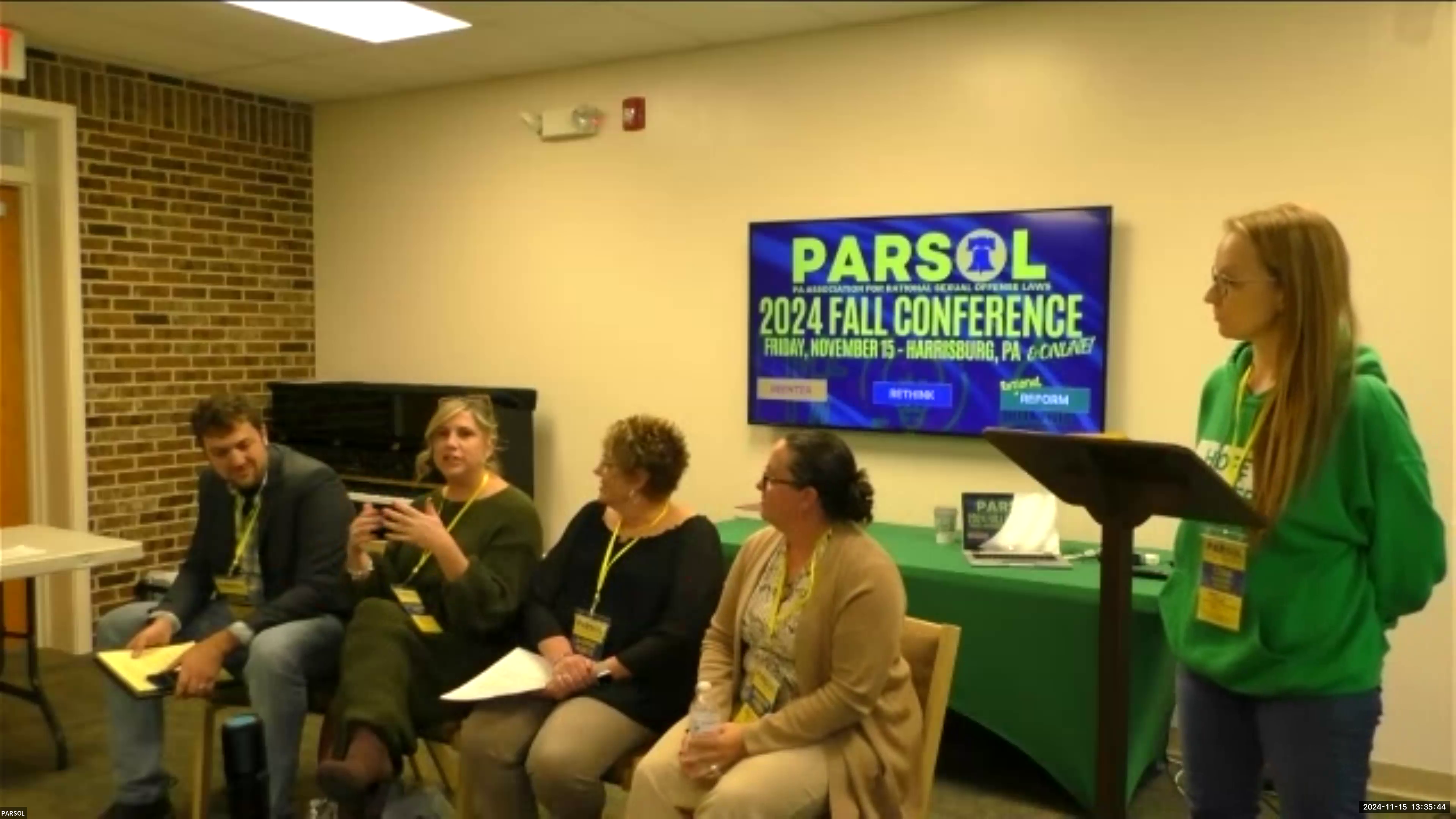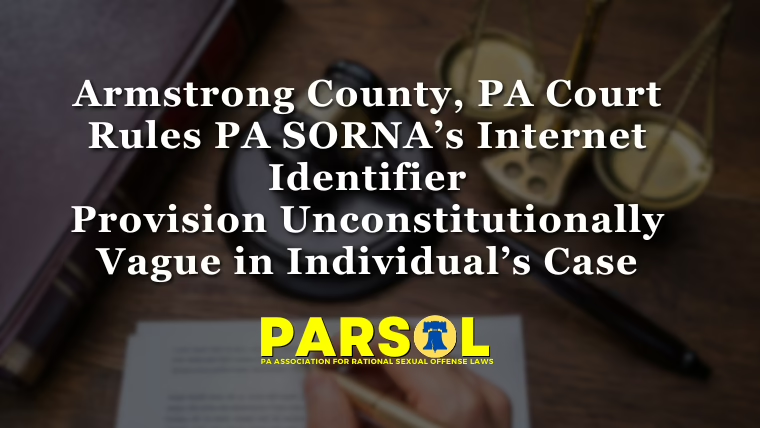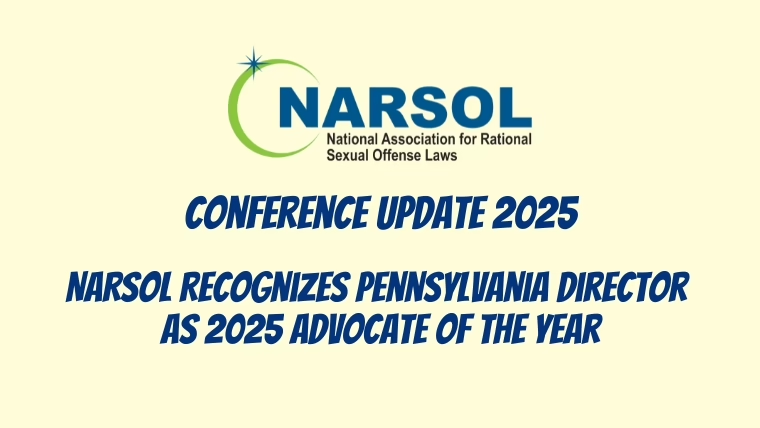Reentry into society after incarceration is a journey fraught with obstacles. For individuals forced to register on the Pennsylvania Megan’s Law registry, these challenges become even more formidable as stigma and restrictive policies compound the difficulties of finding housing, employment, and acceptance. At a recent panel discussion, experts, advocates, and justice-impacted individuals convened to discuss the path forward, sharing insights on restorative justice, systemic advocacy, and the power of community.
This discussion explored several critical themes: balancing public safety with second chances, addressing the unique barriers faced by those on the registry, navigating restrictions, and building supportive communities. The panelists shared professional expertise and personal experiences, offering actionable strategies and heartfelt advice.
The panel brought together a diverse group of voices, each contributing a unique perspective:
- Jordan Kauffman, Executive Director of New Person Ministries, provides transitional housing for individuals reentering society from incarceration, many of whom must register.
- Jacqueline Fusco: Regional Director for the Mid-Atlantic Region at the Center for Employment Opportunities (CEO), a national nonprofit focused on workforce development for justice-impacted individuals.
- Carrie Kurtz: Former Director of the Lancaster County Reentry Coalition and advocate with a history of tackling barriers to reentry and creating systemic change.
- Jennifer Weeks, Ph.D.: Sex Offender Assessment Board (SOAB) approved treatment provider in Eastern Pennsylvania and an advocate for evidence-based practices
- Lisa Kessler-Peters: PARSOL board vice chair-elect, justice-impacted individual, and advocate for restorative justice and community integration.

Balancing Public Safety and Second Chances
The discussion opened with a fundamental question: How can society balance public safety to provide individuals a second chance?
Panelists emphasized that reintegration and public safety are not mutually exclusive. Rather, they are inherently connected. Jacqueline Fusco remarked, “Second chances are helping public safety because when individuals come home from incarceration, providing them with the opportunity to work, live, and give back to their families and communities automatically helps public safety.” She explained that when individuals are denied opportunities, they are more likely to fall into circumstances that increase recidivism.
Jordan Kauffman highlighted the dangers of isolation, stating, “When we isolate people, you might think you’re making your church or community safer, but you’re actually making your community as a whole less safe.” He explained that isolation leads to higher risks of harm, whereas inclusion and community support foster accountability and personal growth.
From a treatment perspective, Dr. Weeks stressed the importance of individualized assessments. “I try to balance that by looking at each person individually—assessing their risk factors and helping them where they need it. Blanket restrictions don’t work.” She pointed out that addressing unique needs helps build pathways for reintegration while mitigating potential risks.
Faith Communities: A Call to Inclusion
Faith-based organizations have a significant role in reentry, but resistance often arises from misunderstandings and fears. Kauffman shared his experiences working with churches through New Person Ministries. “We try to work with churches to create safety plans and show them that welcoming these individuals is a way to help them and strengthen the community.” He noted that some churches are hesitant to take concrete steps, but many open up when they see the humanity of those they are excluding.
Lisa Kessler-Peters shared her deeply personal journey as a justice-involved individual. “As a person forced to register, I saw how grieved the Lord must be by how registrants and reentrants are generally treated. That led me to become a pastor to ensure that all people, no matter their past, are welcomed and loved.” She challenges faith communities to see the divine value in every person and embody restorative justice principles.
Kurtz emphasized the power of questioning assumptions within faith communities. “I like when churches push back because it gives us a platform to ask them, ‘Are you walking out what it means to be the church? Are you loving the marginalized like you’re called to do?’” She highlighted how these conversations often lead to a shift in perspective and greater acceptance.
Employment as a Gateway to Reintegration
Employment is often the cornerstone of successful reentry, yet it remains one of the most challenging barriers, particularly for those on the registry. Fusco explained how her program bridges this gap. “We focus on meeting the employer’s needs first. Once they trust us, we can advocate for individuals based on their skills and track record in our program.”
CEO’s transitional work crews allow participants to gain immediate income and valuable experience. “We become a reference for participants, showing employers that these individuals are reliable and skilled,” Fusco said. She acknowledged that individuals with sexual offenses face unique challenges, but added, “We educate employers that the charges they think are ‘acceptable’ like drug offenses have higher recidivism rates than violent crime or sexual offenses.”
Kauffman noted that sometimes, reentering citizens must think outside the box. “We had a guy with a tech degree who couldn’t get hired. He set himself up as an independent contractor, and suddenly companies were willing to work with him because he wasn’t ‘on their payroll.’ His only downside was that he only made $125,000 that year.” The audience chuckled, but the story underscored the importance of creative solutions.
Community: The Anchor of Reentry
The panelists agreed that community support is essential for successful reintegration. “You need a group of people to talk to, relate to, and encourage you,” said Kurtz. “Community is critical, even when your inner voice tells you lies like ‘no one wants you.'”
Kauffman emphasized that relationships and guidance can make or break reentry. “When guys return from prison they want to catch up for lost time. They’ll try to work two full-time jobs and, without support, they fail. We stress that they need to build relationships and find people who care about them and seek balance in their lives.”
For Kessler-Peters, networking and volunteering played a pivotal role in her own journey. “I started volunteering, which allowed me to meet decision-makers and demonstrate my value. Over time, I moved into leadership roles because people saw my integrity and dedication.” She encouraged others to build connections and prove their worth through action.
Navigating Restrictions
Parole and probation restrictions often hinder reentry, particularly when they limit social interactions or community participation. Jennifer Weeks recounted a frustrating example: “A group of my clients had built a support network among themselves outside of group therapy, but a new supervised release officer shut it down [by telling them they shouldn’t be associating with each other]. It was the best thing they had, and it was taken away.”
Panelists acknowledged that these restrictions are often inconsistently enforced and challenging to navigate. Kauffman shared that creating safety plans in collaboration with parole officers helps protect both the individual and the community. “But the reality is that each parole officer has discretion, and enforcement can be inconsistent,” he said.
Kessler-Peters urged persistence. “Never assume the answer is no. I was told I couldn’t take my kids on a cruise while on probation, but I advocated for myself, got support from my treatment provider, and made it happen.”
Family and Societal Stigma
Stigma extends beyond the justice-impacted individual, affecting their families and even the professionals who support them.
Dr. Weeks described the skepticism she faces. “How can you work with ‘those people’?” is a question she hears often. “My family gets it, but I’ve had friends who assume my work is dangerous. It’s all about ignorance and media-driven perceptions.”
Kurtz said her husband and son initially questioned her work but have grown more supportive over time. “My son texted me last night to say, ‘Be safe and good luck.’ It’s small steps, but sharing stories and humanizing the people we serve makes a difference. The community needs to learn that the dramatic portrayal of Law and Order isn’t a typical reality.”
Kauffman shared a poignant story about his father. “At first, my dad said no when I asked if he’d consider renting one of his apartments to one of our guys. A year later, he not only rented to someone, but essentially adopted him. People’s perceptions change when they see the humanity in someone.”
Advice for Those Beginning Their Reentry Journey
Panelists offered practical and compassionate advice for individuals starting their reentry journey. Dr. Weeks urged patience. “Take a breath. It’s overwhelming, but you’ll get there one step at a time.”
Kurtz emphasized the power of connection. “Find a community of people who can support you. Even when it’s hard, staying connected is critical.”
Fusco stressed the importance of addressing barriers holistically. “At CEO, we focus on reducing barriers to employment, whether that’s mental health support, substance abuse treatment, or access to basic needs like food and clothing.”
Expanding Access to Resources
Audience members noted the difficulty of finding resources, especially during the early stages of reentry. Fusco explained that most of CEO’s referrals come from probation and parole but added, “We also rely on word of mouth and outreach events to connect with people.”
Lisa Kessler-Peters highlighted the need for centralized resources, pointing to organizations like PARSOL working to build databases. “We need volunteers to help build these tools so people know where to turn,” she said, encouraging audience members to contribute to these efforts.
Conclusion: Building a Path Forward
“Our mistakes do not define us. We are loved and valued, and we have the right to rebuild our lives,” added Kessler-Peters during her closing remarks. “Our work today is about breaking cycles, building communities, and creating opportunities for those who need it most.”
The panelists’ insights remind us that second chances are not just a gift to individuals but an investment in safer, stronger communities. Through collaboration, education, and unwavering advocacy, we can create a society where everyone has the opportunity to thrive.



![stuckIn1995_rally_header - PARSOL - Pennsylvania Assoc for Rational Sex Offense Laws (PA Megan's Law Resources) PARSOL Board Chair Josiah Krammes speaks at the PA Capitol Rotunda flanked by State Reps. Emily Kinkead and Tim Briggs (28 Oct 2025) [John Dawe/PARSOL]](https://parsol.org/wp-content/uploads/2025/10/stuckIn1995_rally_header.avif)
